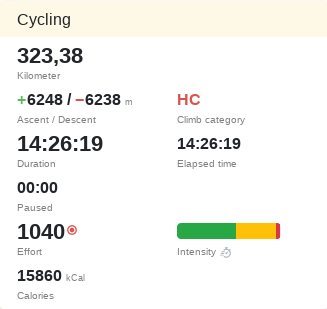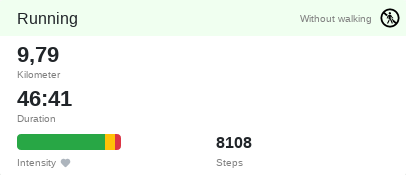Activity summary
Activity summary
The summary gives you an overview of the effort and intensity of your activity.
Distance
By default, the distance is aggregated from the distance series of your sports watch.
By clicking on the distance field, you can also calculate the distance derived from speed.
This can be beneficial with a well-adjusted additional speedometer, but is less accurate with normal GPS watches. The two data sources are described in more detail in the description of "Pace by Distance" and "Pace by Speed".
In the preferences category, you can permanently set the primary distance source.

Lengths and pool length
In addition to the distance, the length of the pool and the number of lengths that you swam are displayed.
Ascent and Descent
As no ascent or descent is absolutely straight, but is always a little up and down, the covered vertical meters are mostly much larger than the direct height difference. The ascent and descent show you the actual difference in altitude you have covered.
Climb category
The climb category is based on the categorization of the climbs in the Tour de France and reaches from '5' to 'HC'.
A category '5' climb requires only a small difference in elevation, whereas category 'HC' is the highest category, requiring a very high climbing performance.
The climb category is determined from the calculated Fiets Index. Tredict has calculated the Fiets indicies for the climbs of the Tour de France and can therefore also calculate the climb category.
Duration
Duration is the main factor for the effort calculation of an activity. Only the active time is used for this and breaks are not included.
Tredict also shows you the time you have spent walking while running or standing instead of sitting while cycling.
The elapsed time is the period from the start time to the end time of the workout, including all breaks.
Split
The split indicates the time difference of the second half of an activity. A run of 10 kilometers is thus divided at kilometer 5.
Negative split
A negative split is an activity in which the second half was performed faster. This can have natural reasons, for example, the fast descent from a mountain in the second half. However, negative splits are also deliberately planned and say something about the ability to control intensity.
Positive split
With a positive split, the second half of an activity takes longer to complete. This could be the case if, for example, you first run fast down the valley and then have to run back up the mountain. But a positive split can also mean that you started a run or bike race too fast at the beginning.
Identical split
In an identical split or even split, both halves of the activity are the same duration. An "even split" can show the ability to control intensity at a constant rate.

Effort
The effort is the input variable for the performance chart and influences your fitness and exhaustion.
Low efforts are marked green, moderate yellow and high red. For high accuracy you should regularly adjust the zones to your current fitness level and maintain zone revisions.
The effort is calculated using the following criteria:
- Active Duration - The longer the activity, the higher the effort.
- One of the 3 performance values - heart rate, wattage or speed.
- Zone Intensity - A higher intensity range increases effort over the same time.
- Capacity - Maximum heart rate, FTP, FTPa
Which of the performance values should be prioritized in the calculation, the zone priority, can be defined in the preferences in the settings category.
Intensity distribution
The distribution of the intensities allows you to quickly classify the type of training or whether you have been in the desired intensity ranges.
Tredict defines 3 intensity ranges - low, moderate and high.
With a click on the intensity distribution you can switch between zone types - heart rate, power, speed and cadence.
For an even more detailed overview, you can look at the zone distribution in your training.
Calories
The calorie consumption is measured in kCal. It can be important, for example, during particularly long runs or for precise control of food intake, in the final phase of a training period.
Steps, Pedalstrokes and Strokes
The number of steps when running, pedalstrokes when cycling and swim strokes when swimming depend on the cadence and duration of a workout.
Show running activity without walking

In a running activity, you can hide the time you spent walking in the series chart, in the performance values and in the summary. To do this, click on the walking symbol in the summary.
This can be useful, for example, when analyzing interval training to compare the performance phases more easily.